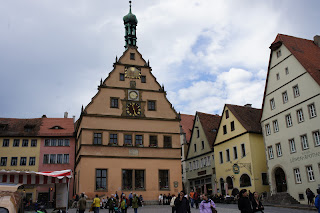However, as extensive canal works have made the Main navigable for river shipping, there are quite a number of large locks which present much work for the captain and crew to traverse across. (We encountered 68 locks throughout our total voyage of the 3 rivers). When navigating through these deep canals, it is best to situate yourselves on the sundeck as the feeling in the cabin is similar to being stalled in a protracted subway tunnel. Wifi is also negligeable, making it quite an arduous task to load pics and work on the blog in real time...thus the blog was put on hold for the remainder of our journey.
First off after breakfast, we embarked on a guided tour of the Wurzburg Residence Palace - the home of the former Prince Bishop, now a declared world heritage site. The palace is a magnificent example of Baroque style art. Its main staircase is enormous in span with the world's largest ceiling of its time, designed by court architect Balthasar Neumann who had to fight concerns about the dangers of such an enormous vault. Of more elegance though, we considered, is the White Hall in Neoclassical style intricately decorated with white stucco..some painted to resemble drapery effect and enhances the 3 dimensional perception that characterized much of the Baroque fresco style. It was told to us that the renowned artist, Antonio Bossi went mad later with the stress imposed by Emperor Fredrick I Barbarossa's order to complete the White Hall in 9 month...all to no avail as when the newlywed Princess Beatrix of Burgundy entered the palace, she never even noticed the masterpiece he had slaved over.
Ceiling fresco reputed to be even larger than Rome's St. Peter's Basilica - by Venetian painter Giovanni Tiepolo- it depicts four continents: Europe, America, Asia & Africa
The White Hall
What looks like hanging drapery from the ceiling is actually painted and finely crafted paper-maches

Entrance to the palace garden grounds
This was hilltop fortress that Wurzburg Prince Bishop formerly resided - prior to his commissioning in 1720 of the Wurzburg Palace Residenz. Back in the 13th Century, the practice was that local regional Bishops were given the status of "prince-bishop" by the ruling Emperors. this made the bishop not only the religious ruler but the secular ruler as well. They thus became fabulously wealthy and powerful until Napoleon abolished this in 1803 with the creation of the "Kingdom of Bavaria".
Wurzburg in northernwestern Bavaria is part of the Franconia sub-region. It is surrounded by the pretty vine clad slopes & is a city notable as recipient of the first Nobel prize for the invention of the X-ray by Wilhelm Rontgen in 1895.
Instead of choosing between two enticing options, we decided in the afternoon to each do one. Tom took the bike tour which departed from Wurzburg to Kitzingen after lunch - a 40 km ride, oouch! Ellen stayed with much of the tour group and joined in an optional guided tour of what Uwe (our cruise director) promised to be "the most picturesque village" in all of Germany - Rothenburg. This is home of the famous German original Kathe Wohlfhrt Christmas Store and an often visited Medieval Torture Museum. But before that, of course an interesting local guide took us along a pleasant stroll in the cobble stoned streets of Rothenburg.
Patron Saint George slaying dragon

Signature Franconian Bockbeutels, a sort of flattened ellipsoid reserved for quality approved wines - regulation 2002 passed by the EU council. Amusing stories abound re origin of this beloved shape. It was used by the monks to disguise them in cloaks as prayer books, or it originated from the term "ram's scrotum", which is supposed to be of similar shape..lol


Amusing folklore was told by the guide about the wonderful qualities of the Franconian Wine. The story of Der Meistertrunk (The Master Draught) took place in1631as Georg Nusch, took one of the most famous drinks in history to save the town's councilmen from death. This drama during the Thirty Years' War came to be when the legendary General Tilly's victorious army stood within Rothenburg's walls and declared that all councilmen were to loose their heads. After this declaration, the citizens of Rothenburg filled the Pokal, the huge state beaker, to the brim with the town's best wine. General Tilley and his men, try as they may, could never completely empty the drinking vessel. Tilly then declared : If there was a Rothenburg man who could drink the contents of the goblet at a single gulp, he would agree not to take off the councilmen's heads on the next dawn. A deep hush was followed by a big flurry of excitement, as Georg Nusch, volunteered for the challenge and in presence of General Tilley, drained the Pokal and then fainted. This was the heroic tale that is still being celebrated each summer in the old town of Rothenburg.
Dirndls and Lederhosens
View from city wall lookout of franconia surroundings
Entrance to Torture Museum
Give me a break - a heart shaped detail on chastity belt ?!?!
Various punishment mask to be worn by village residents caught with moral infractions ie- gossiping or even just for dressing inappropriately
Amadolce docked in Kitzingen in the late afternoon & the 4 bikers, Tom included, returned heroically to join the rest of the group for dinner. The bikers in fact beat our bus to town and already concluded a walk around and visited "Dracula's Den" . Here are some pics taken by Tom's iphone..
Post dinner, we were treated to a visit to an old Franconian wine celler and tasted several types of specialty wines from the region. Needless to say, for some of us, the walk back to the ship seems just slightly wobbly .. could only be land sickness ..no ??

In the oldest wine cellar of Germany



















































